샤프닝 카바이드 인서트 는 내구성과 정밀도를 위해 설계된 기계 가공 분야의 필수 도구입니다. 하지만 아무리 단단한 카바이드 인서트도 성능을 유지하려면 연마가 필요합니다. 이 포괄적인 가이드에서는 카바이드 인서트의 구성 이해부터 올바른 샤프닝 방법 선택에 이르기까지 카바이드 인서트 샤프닝의 핵심을 자세히 설명합니다. 이 가이드는 숙련된 기공사든 이제 막 시작하는 기공사든 알아야 할 모든 것을 안내합니다.
샤프닝 카바이드 인서트 개요
카바이드 인서트는 금속 가공에 사용되는 작지만 강력한 부품으로, 뛰어난 경도와 내마모성을 제공합니다. 이 인서트는 텅스텐 카바이드와 코발트의 조합으로 제작되어 내구성이 매우 뛰어납니다. 하지만 시간이 지나면 인서트의 날이 무뎌져 절삭 성능을 회복하기 위해 날카롭게 연마해야 할 수 있습니다.
카바이드 인서트를 샤프닝해야 하는 이유는?
카바이드 인서트의 효율성을 유지하고 수명을 연장하려면 인서트를 연마하는 것이 중요합니다. 무딘 인서트는 절삭 품질이 떨어지고 공구 마모가 증가하며 심지어 공작물 손상으로 이어질 수 있습니다. 정기적으로 샤프닝을 하면 인서트가 날카로운 상태를 유지하여 더 깔끔한 절삭을 제공하고 전반적인 생산성을 향상시킬 수 있습니다.
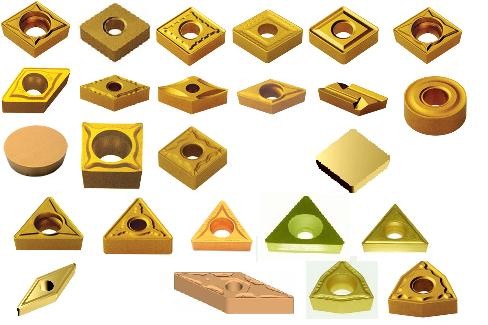
샤프닝 카바이드 인서트의 종류
카바이드 인서트는 다양한 유형이 있으며, 각 유형은 특정 용도에 맞게 설계되었습니다. 다음은 카바이드 인서트의 일반적인 유형과 그 용도를 요약한 표입니다:
| 삽입 유형 | 설명 | 애플리케이션 |
|---|---|---|
| CNMG | 네거티브 레이크 각도, 양면 | 일반 선삭 및 밀링 |
| TNMG | 삼각형, 음의 경사각 | 황삭 및 마무리 |
| SNMG | 정사각형, 음의 경사각 | 무거운 러프닝 |
| DNMG | 다이아몬드 모양의 음의 경사각 | 섬세한 마무리 |
| WNMG | 트라이곤, 음의 경사각 | 중간에서 무거운 러프닝 |
| CCMT | 포지티브 레이크 각도, 단면 | 마무리 및 라이트 커팅 |
| DCMT | 다이아몬드 모양의 양수 레이크 각도 | 정밀 마감 |
| VBMT | 마름모꼴, 양의 경사각 | 정밀 마감 및 프로파일링 |
| RCMT | 원형, 양의 경사각 | 컨투어링 및 프로파일링 |
| APKT | 직사각형, 양의 경사각 | 밀링 |
애플리케이션 샤프닝 카바이드 인서트
초경 인서트의 연마는 다양한 가공 공정에 필수적입니다. 응용 분야마다 다른 인서트 유형과 샤프닝 기술이 필요합니다:
| 애플리케이션 | 삽입 유형 | 선명하게 하는 기술 |
|---|---|---|
| 선회 | CNMG, TNMG, DMMG | 연마, 연삭 |
| 밀링 | APKT, RCMT | 다이아몬드 휠 연삭 |
| 드릴링 | CCMT, DCMT | 다이아몬드 페이스트 연마 |
| 프로파일링 | VBMT, RCMT | 다이아몬드 스톤으로 핸드 연마 |
| 러프닝 | SNMG, WNMG | CBN 휠로 연삭 |
카바이드 인서트의 재료 특성
올바른 샤프닝 방법을 선택하려면 카바이드 인서트의 재료 특성을 이해하는 것이 중요합니다. 다음은 주요 속성에 대한 분석입니다:
| 속성 | 설명 |
|---|---|
| 경도 | 매우 하드, 일반적으로 85-92 HRA |
| 인성 | 높은 인성, 파손 방지 |
| 내마모성 | 카바이드 성분으로 인한 뛰어난 내마모성 |
| 열 안정성 | 고온에서 경도 유지 |
| 내화학성 | 부식 및 화학 반응에 대한 내성 |
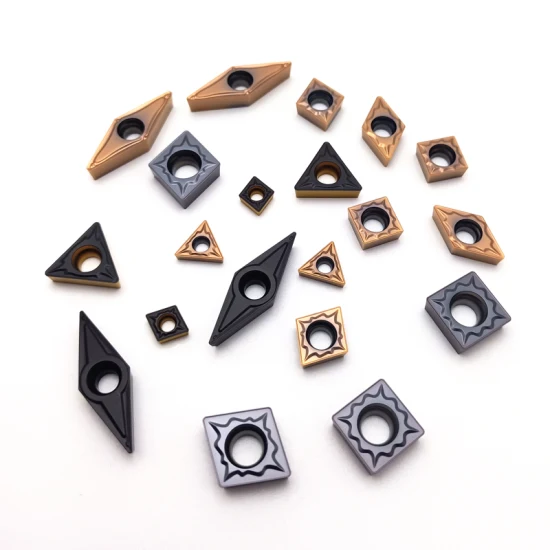

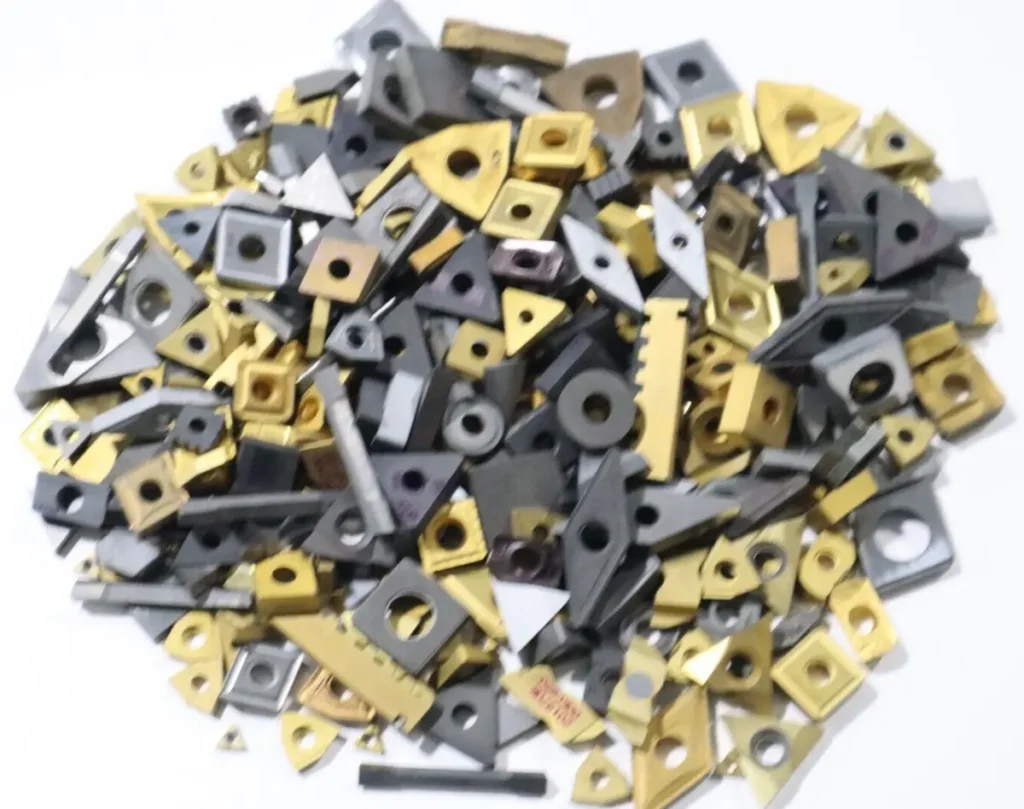
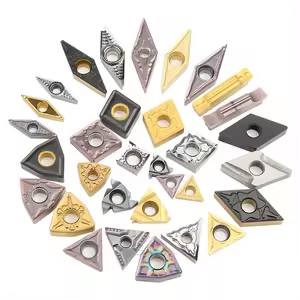
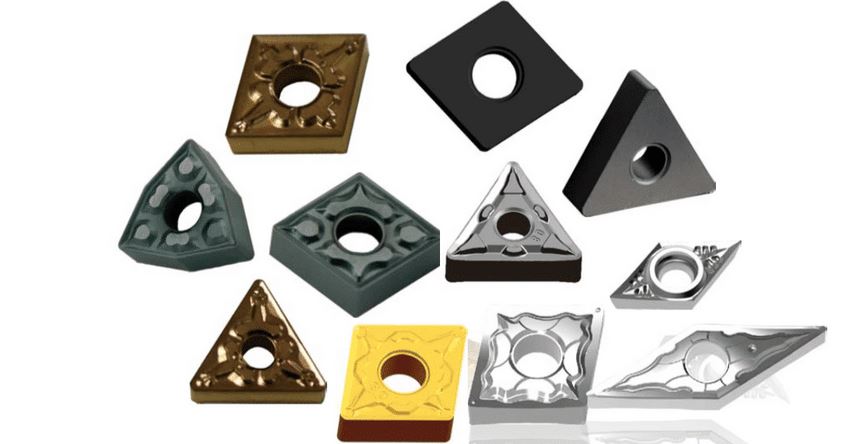
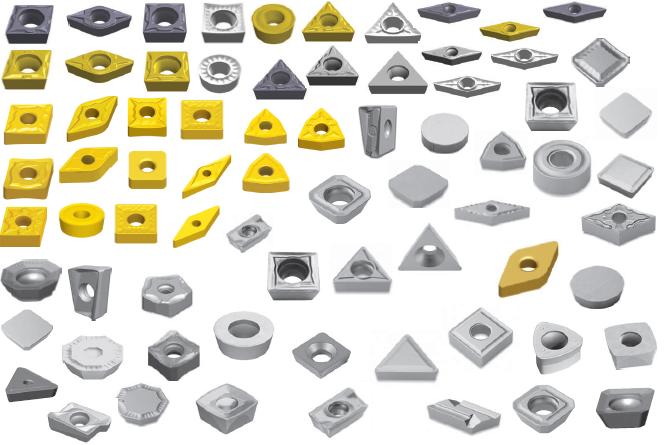
구성, 속성 및 특성
카바이드 인서트는 주로 텅스텐 카바이드와 코발트로 구성되며, 각각 고유한 특성을 가지고 있습니다:
| 구성 요소 | 역할 | 특성 |
|---|---|---|
| 텅스텐 카바이드 | 경도 제공 | 매우 단단하고 내마모성이 뛰어남 |
| 코발트 | 바인더 역할 | 인성 및 내구성 향상 |
| 티타늄 카바이드 | 선택적 추가 | 경도 및 내마모성 향상 |
| 탄탈 탄화물 | 선택적 추가 | 인성 및 열 안정성 향상 |
경도, 강도 및 내마모성
카바이드 인서트는 인상적인 경도, 강도 및 내마모성으로 잘 알려져 있습니다. 다음은 이러한 특성을 비교한 것입니다:
| 속성 | 설명 |
|---|---|
| 경도 | 85~92 HRA의 범위로, 가장 단단한 소재 중 하나입니다. |
| 힘 | 높은 압축 강도, 변형에 대한 내성 |
| 내마모성 | 뛰어난 내마모성으로 고속 가공에 이상적 |
사양, 크기, 모양 및 표준
카바이드 인서트는 다양한 모양과 크기로 제공되며, 일관된 성능을 위해 업계 표준을 준수합니다:
| 사양 | 세부 정보 |
|---|---|
| 크기 | 일반적인 크기에는 1/4″, 1/2″, 3/4″ 인서트가 포함됩니다. |
| 도형 | 정사각형, 삼각형, 다이아몬드, 원형, 마름모꼴 |
| 표준 | ISO, ANSI 및 DIN 표준으로 호환성 및 품질 보장 |
공급업체 및 가격 세부 정보
고품질 카바이드 인서트를 얻으려면 올바른 공급업체를 선택하는 것이 중요합니다. 다음은 평판이 좋은 공급업체 목록과 가격 세부 정보입니다:
| 공급업체 | 위치 | 가격 범위 |
|---|---|---|
| 샌드빅 코로만트 | 글로벌 | 인서트당 $5 - $20 |
| 케나메탈 | 글로벌 | 인서트당 $10 - $30 |
| ISCAR | 글로벌 | 인서트당 $8 - $25 |
| 미쓰비시 머티리얼즈 | 글로벌 | 인서트당 $12 - $35 |
| 스미토모 전기 | 글로벌 | 인서트당 $15 - $40 |
오른쪽 선택 샤프닝 카바이드 인서트
올바른 샤프닝 방법을 선택하는 것은 인서트의 유형, 가공되는 재료, 원하는 마감 등 다양한 요인에 따라 달라집니다. 다음은 올바른 샤프닝 카바이드 인서트를 선택하는 데 도움이 되는 가이드입니다:
| 팩터 | 고려 사항 | 권장 샤프닝 방법 |
|---|---|---|
| 삽입 유형 | 포지티브 레이크와 네거티브 레이크 | 네거티브 레이크용 다이아몬드 휠 연마, 포지티브 레이크용 다이아몬드 페이스트 연마 |
| 재질 | 경도 및 인성 | 단단한 소재는 다이아몬드 휠이 필요하고 부드러운 소재는 CBN 휠을 사용할 수 있습니다. |
| 원하는 마감 | 러프닝과 피니싱 | 마무리는 더 미세한 연마가 필요하고 황삭은 더 거친 연삭을 사용할 수 있습니다. |
장점과 한계
초경 인서트 샤프닝의 장점과 한계를 이해하면 정보에 입각한 결정을 내리는 데 도움이 될 수 있습니다:
| 측면 | 장점 | 제한 사항 |
|---|---|---|
| 성능 | 절삭 효율 유지, 공구 수명 연장 | 정밀한 기술이 필요하고 시간이 많이 소요될 수 있습니다. |
| 비용 | 인서트 교체에 비해 비용 효율적 | 샤프닝 장비에 대한 초기 투자 |
| 다용도성 | 다양한 가공 공정에 사용 가능 | 사용 가능한 샤프닝 장비의 종류에 따라 제한됨 |
선명하게 하는 기술: 올바른 방법을 선택하는 방법
카바이드 인서트의 성능을 유지하려면 올바른 샤프닝 기술을 선택하는 것이 중요합니다. 다음은 몇 가지 일반적인 샤프닝 방법과 그 적용에 대해 자세히 살펴보는 내용입니다:
다이아몬드 스톤으로 연마하기
다이아몬드 스톤을 사용한 호닝은 마감 및 프로파일링에 이상적인 정밀한 방법입니다. 이 기술은 미세한 입자의 다이아몬드 스톤으로 인서트를 수동으로 연마하여 재료를 너무 많이 제거하지 않고도 날카로운 모서리를 보장합니다.
CBN 휠을 사용한 연삭
CBN(입방정 질화 붕소) 휠은 황삭 및 무거운 재료 제거에 탁월합니다. 이 방법은 CBN 휠을 사용하여 인서트를 연마하여 날카로운 모서리를 제공하고 인서트의 형상을 유지합니다.
다이아몬드 휠 연삭
다이아몬드 휠 연삭은 황삭과 정삭 모두에 적합한 다용도 방법입니다. 이 기술은 다이아몬드 휠을 사용하여 인서트를 연마하여 날카롭고 튼튼한 모서리를 보장합니다.
다이아몬드 페이스트 호닝
다이아몬드 페이스트 호닝은 거울과 같은 마감을 구현하는 데 이상적인 미세 조정 방법입니다. 이 기법은 다이아몬드 페이스트를 호닝 도구에 바르고 인서트를 조심스럽게 연마하여 면도날처럼 날카로운 모서리를 만드는 것입니다.
카바이드 인서트 샤프닝: 단계별 가이드
카바이드 인서트를 연마하려면 정밀도와 올바른 도구가 필요합니다. 다음은 시작하는 데 도움이 되는 단계별 가이드입니다:
- 도구 모으기: 다이아몬드 스톤, CBN 휠, 연마 페이스트 등 필요한 연마 도구가 있는지 확인하세요.
- 인서트 청소: 부드러운 솔과 세척액을 사용하여 인서트에 묻은 이물질이나 쌓인 이물질을 제거합니다.
- 삽입물 고정: 샤프닝 중 움직이지 않도록 인서트를 안전한 고정 장치에 놓습니다.
- 선명하게 하는 방법 선택: 인서트 유형과 원하는 마감에 따라 적절한 샤프닝 방법을 선택합니다.
- 인서트 선명하게 하기: 일정한 압력과 각도를 유지하면서 인서트를 조심스럽게 갈아줍니다.
- 엣지 검사: 인서트의 가장자리가 선명하고 균일한지 확인합니다. 필요한 경우 이 과정을 반복합니다.
- 청소 및 보관: 인서트를 다시 세척하고 손상을 방지하기 위해 안전한 곳에 보관하세요.
선명하게 하는 방법 비교하기: 어떤 것이 가장 좋을까요?
샤프닝 방법마다 다양한 장점과 한계가 있습니다. 각자의 필요에 가장 적합한 방법을 선택하는 데 도움이 되는 비교표를 소개합니다:
| 방법 | 장점 | 제한 사항 |
|---|---|---|
| 다이아몬드 스톤 | 정밀하고 이상적인 마무리 작업 | 시간이 많이 걸리고 기술이 필요합니다. |
| CBN 휠 | 효율적이고, 러프닝에 적합 | 조심스럽게 사용하지 않으면 너무 많은 재료를 제거할 수 있습니다. |
| 다이아몬드 휠 연삭 | 다재다능하고 내구성이 뛰어난 엣지 | 특수 장비 필요 |
| 다이아몬드 페이스트 호닝 | 섬세한 마감, 날카로운 모서리 | 큰 선명도가 아닌 작은 조정에 적합 |
초경 인서트 샤프닝을 위한 유지보수 팁
카바이드 인서트의 수명과 성능을 보장하기 위해서는 적절한 유지 관리가 중요합니다. 다음은 인서트를 최상의 상태로 유지하기 위한 몇 가지 팁입니다:
- 정기 청소: 인서트를 정기적으로 청소하여 이물질과 쌓인 이물질을 제거하세요.
- 적절한 보관: 인서트가 손상되지 않도록 건조하고 안전한 곳에 보관하세요.
- 시기적절한 선명도: 과도한 마모를 방지하기 위해 성능이 저하되는 것을 발견하는 즉시 인서트를 갈아주세요.
- 품질 도구 사용: 최상의 결과를 위해 고품질 샤프닝 도구에 투자하세요.
- 모니터 마모: 인서트의 마모 패턴을 주시하고 그에 따라 샤프닝 기술을 조정하세요.

자주 묻는 질문
| 질문 | 답변 |
|---|---|
| 카바이드 인서트는 어떤 용도로 사용되나요? | 초경 인서트는 다양한 재료를 절단, 선삭, 밀링 및 드릴링하는 가공에 사용됩니다. |
| 카바이드 인서트는 얼마나 자주 연마해야 하나요? | 애플리케이션과 자료에 따라 다르지만 일반적으로 성능 저하를 발견할 때입니다. |
| 카바이드 인서트를 직접 연마할 수 있나요? | 예, 올바른 도구와 기술을 사용하면 카바이드 인서트를 직접 연마할 수 있습니다. |
| 카바이드 인서트를 연마하는 가장 좋은 방법은 무엇인가요? | 가장 좋은 방법은 인서트 유형과 용도에 따라 다르지만 다이아몬드 휠 연삭은 다양하고 효과적인 옵션입니다. |
| 카바이드 인서트를 연마해야 하는 이유는 무엇인가요? | 샤프닝은 절삭 효율을 유지하고 공구 수명을 연장하며 고품질의 가공 결과를 보장합니다. |
결론
샤프닝 카바이드 인서트 은 모든 기계 기술자에게 필수적인 기술입니다. 다양한 유형의 인서트와 그 용도, 최상의 샤프닝 기술을 이해하면 공구의 날카로움과 효율성을 유지할 수 있습니다. 다이아몬드 스톤으로 연마하든 CBN 휠로 연마하든 올바른 접근 방식을 사용하면 인서트의 성능을 최상으로 유지할 수 있습니다.




